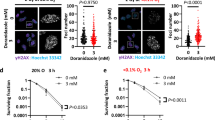Abstract
Purpose: The antimalarial agent, artemisinin, also confers cancer-specific cytotoxic effects by reacting with ferrous iron atoms to form free radicals. Here, we investigated the radiosensitizing effects of dihydroartemisinin on glioma cells and assessed some possible mechanisms for these effects. Materials and methods: U373MG glioma cells treated with various concentrations of dihydroartemisinin plus radiation, and efficiency of radiosensitization was assessed by clonogenic survival assay. Expression and activity of antioxidant enzymes, glutathione-S-transferase (GST) were quantified by western blot and enzymatic activity analyses, respectively. Results: Dihydroartemisinin showed higher cytotoxicity in the glioma cell lines than in the liver, breast or cervical cancer cell lines. In clonogenic survival assays, treatment with dihydroartemisinin alone dose-dependently reduced the number of U373MG colonies, while treatment with dihydroartemisinin plus γ-irradiation showed far lower clonal survival than cultures treated with radiation or dihydroartemisinin alone. The radiosensitizing effect of dihydroartemisinin was blocked significantly by the free radical scavengers, NAC and TIRON, indicating association with dihydroartemisinin-induced ROS generation. In addition, the radiation-induced expression of endogenous GST was suppressed by treatment with dihydroartemisinin. The radiosensitizing effect of dihydroartemisinin was also markedly enhanced by the addition of holotransferrin Conclusion: Taken together, our results strongly suggest that dihydroartemisinin triggers production of ROS and inhibits GST activity, leading to effective and therapeutically relevant radiosensitization of human glioma cells.





Similar content being viewed by others
References
Biaglow JE, Clark EP, Epp ER, Morse-Guadio M, Varnes ME, Mitchell JB (1983) Nonprotein thiols and the radiation response of A549 human lung carcinoma cells. Int J Radiat Biol 44:489–495
Brewer TG, Grate SJ, Peggins JO et al (1994) Fatal neurotoxicity of arteether and artemether. Am J Trop Med Hyg 51:251–259
Davis LW (1989) Malignant glioma—a nemesis which requires clinical and basic investigation in radiation oncology. Int J Radiat Oncol Biol Phys 16:1355–1365
Dell’Eva R, Pfeffer U, Vene R, Anfosso L, Forlani A, Albini A, Efferth T (2004) Inhibition of angiogenesis in vivo and growth of Kaposi’s sarcoma xenograft tumors by the anti-malarial artesunate. Biochem Pharmacol 68:2359–2366
Efferth T, Volm M (2005) Glutathione-related enzymes contribute to resistance of tumor cells and low toxicity in normal organs to artesunate. In Vivo 19:225–232
Efferth T, Dunstan H, Sauerbrey A, Miyachi H, Chitambar CR (2001) The anti-malarial artesunate is also active against cancer. Int J Oncol 18:767–773
Efferth T, Davey M, Olbrich A, Rücher G, Gebbart E, Daveu R (2002) Activity of drugs from traditional Chinese medicine towards sensitive and MDRI- or MRPI-overexpressing multidrug-resistant human CCRF-CEM leukenna cells. Blood Cells Mol Dis 28:160–168
Freeman BA, Crapo JD (1982) Biology of diseases: free radicals and tissue injury. Lab Invest 47:412–426
Hall EJ, Astor M, Bedford J, Borek C, Curtis SB, Fry M, Geard C, Hei T, Mitchell J, Oleinick N et al (1988) Basic radiobiology. Am J Clin Oncol 11:220–252
Henderson CJ, McLaren AW, Moffat GJ, Bacon EJ, Wolf CR (1998) Pi-class glutathione S-transferase: regulation and function. Chem Biol Interact 111–112:69–82
Klayman DL (1985) Qinghaosu (artemisinin): an antimalarial drug from china. Science 228:1049–1055
Lai H, Singh NP (1995) Selective cancer cell cytotoxicity from exposure to dihydroartemisinin and holotransferrin. Cancer Lett 91:41–46
Lai H, Sasaki T, Singh NP, Messay A (2005) Effects of artemisinin-tagged holotransferrin on cancer cells. Life Sci 76:1267–1279
Mahaley MS Jr, Mettlin C, Natarajan N, Laws ER Jr, Peace BB (1989) National survey of patterns of care for brain-tumor patients. J Neurosurg 71:826–836
Moore JC, Lai H, Li JR, Ren RL, McDougall JA, Singh NP, Chou CK (1995) Oral administration of dihydroartemisinin and ferrous sulfate retarded implanted fibrosarcoma growth in the rat. Cancer Lett 27:83–87
Mukanganyama S, Widersten M, Naik YS, Mannervik B, Hasler JA (2002) Inhibition of glutathione S-transferases by antimalarial drugs possible implications for circumventing anticancer drug resistance. Int J Cancer 97:700–705
Onda K, Davis RL, Shibuya M, Wilson CB, Hoshino T (1994) Correlation between the bromodeoxyuridine labeling index and the MIB-1 and Ki-67 proliferating cell indices in cerebral gliomas. Cancer 74:1921–1926
Recht L, Torres CO, Smith TW, Raso V, Griffin TW (1990) Transferrin receptor in normal and neoplastic brain tissue: implications for brain-tumor immunotherapy. J Neurosurg 72:941–945
Repine JE, Pfenninger OW, Talmage DW, Berger EM, Pettijohn DE (1981) Dimethyl sulfoxide prevents DNA nicking mediated by ionizing radiation or iron/hydrogen peroxide-generated hydroxyl radical. Proc Natl Acad Sci USA 78:1001–1003
Sadava D, Phillips T, Lin C, Kane SE (2002) Transferrin overcomes drug resistance to artemisinin in human small-cell lung carcinoma cells. Cancer Lett 179:151–156
Scott MD, Meshnick SR, Eaton JW (1989) Superoxide dismutase amplifies organismal sensitivity to ionizing radiation. J Biol Chem 264:2498–2501
Shitara N, Kitamura K, Wada T, Nakamura H, Takata K (1989) Transferrin receptor molecules in human cell lines derived from the CNS malignant gliomas: immunohistochemical and flow-cytometric study. Acta Histochem Cytochem 22:275–288
Shterman N, Kupfer B, Moroz C (1991) Comparison of transferring receptors, iron content and isoferritin profile in normal and malignant human breast cell lines. Pathobiology 59:19–25
Singh NP, Lai H (2001) Selective toxicity of dihydroartemisinin and holotransferrin toward human breast cancer cells. Life Sci 70:49–56
Taghian A, DuBois W, Budach W, Baumann M, Freeman J, Suit H (1995) In vivo radiation sensitivity of glioblastoma multiforme. Int J Radiat Oncol Biol Phys 32:99–104
Van Agtmael MA, Eggelte TA, van Boxtel CJ (1999) Artemisinin drugs in the treatment of malaria: from medicinal herb to registered medication. Trends Pharmacol Sci 20:199–204
Yamaguchi S, Sakurada S, Nagumo M (1994) Role of intracellular SOD in protecting leukemic and cancer cells against superoxide and radiation. Free Radic Biol Med 17:389–395
Zovickian J, Johnson VG, Youle RJ (1987) Potent and specific killing of human malignant brain tumor cells by an anti-transferrin receptor antibody-ricin immunotoxin. J Neurosurg 66:850–861
Acknowledgements
This work was supported by the National Cancer Center grant 0410052-2.
Author information
Authors and Affiliations
Corresponding author
Additional information
S.J. Kim·and M.S. Kim contributed equally to this work.
Rights and permissions
About this article
Cite this article
Kim, S.J., Kim, M.S., Lee, J.W. et al. Dihydroartemisinin enhances radiosensitivity of human glioma cells in vitro. J Cancer Res Clin Oncol 132, 129–135 (2006). https://doi.org/10.1007/s00432-005-0052-x
Received:
Accepted:
Published:
Issue Date:
DOI: https://doi.org/10.1007/s00432-005-0052-x




